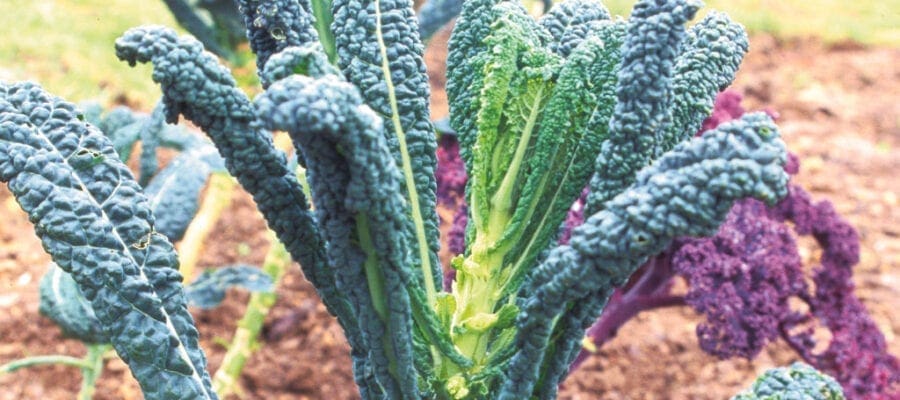Kale or borecole is one of the best winter greens you can grow and just packed with health-giving nutrients. It is a member of the brassica family so is closely related to cabbages and broccoli but probably a bit easier to grow.
It will do well on most soils, although a more limey soil is better than an acidic one. It is an incredibly hardy crop, standing up to severe weather, and seems to be much more resistant to attacks from the traditional brassica pests.
Whitefly is probably the most troublesome, but a quick squirt of water regularly will help keep numbers down. There are lots of varieties with some spectacular shapes and colours. This crop shouldn’t be banished to the veg garden, it should be grown in your flower borders!
Kale Varieties
- ‘Black Tuscany’ (‘Nero di Toscana’)
Produces very long, slender, deep green leaves that have a Savoy cabbage look to them. A wonderful flavour. Can also be harvested when really small as salad leaves. - ‘Red Russian’
A flatter leaf with curly edge. Has good flavour, especially after frost. - ‘Redbor F1’
A stunning variety with heavily crinkled purple-red leaves. Why not grow alternate green kale and ‘Redbor’ for a stunning show. - ‘Starbor F1’
A very crinkly green variety that is ideal for growing at close spacings, so good for a small veg patch. - ‘Reflex F1’
Good-sized plants with very curly dark green leaves. Has a RHS Award of Garden Merit.

Sowing & growing kale
Kale likes a sunny, or partly sunny, site and a good fertile soil. When preparing to sow or plant, the ground needs to be dug over and a sprinkling of Growmore or chicken manure pellets applied.
It may be that the kale will be following a crop of early potatoes or peas so remove all the debris, dig over, then firm by walking over it before planting.
Kale can be sown direct outside in a seed bed. This is basically an area of ground devoted to starting off young plants from seed. The seeds can be sown quite thickly, 2cm (3⁄4in) deep, in rows in the seed bed.
Once seedlings are through remove some and keep thinning out as they grow to leave space between plants. Once they get to about 10cm (4in) high, which will be about June time, they can be then planted out into their proper rows about 45cm (18in) apart.
Kale can also be sown in pots or cell trays and placed on a greenhouse bench or a windowsill. Once all danger of frost has passed they can be planted outside which will be about June.
Growing on kale
When planting make sure you firm well around the roots. Keep the young kale plants free from pest attack by covering with some Enviromesh.
Make sure the plants are well watered and add some high nitrogen feed occasionally. Remove any yellowing leaves and be vigilant for whiteflies, which tend to live on the under surface of the leaves.
Keep the plants weed free and firm the soil around the stems occasionally to prevent them being pushed over by the wind.
Once the plants have reached a decent size you can start picking off some of the leaves. Choose ones near the top but avoid taking out the very growing tip of the plant.
Scrumptious recipes for your homegrown kale
More on kale
More grow guides
For more growing tips and guides, you should subscribe to Kitchen Garden – you’ll receive free seeds with every single issue too!





